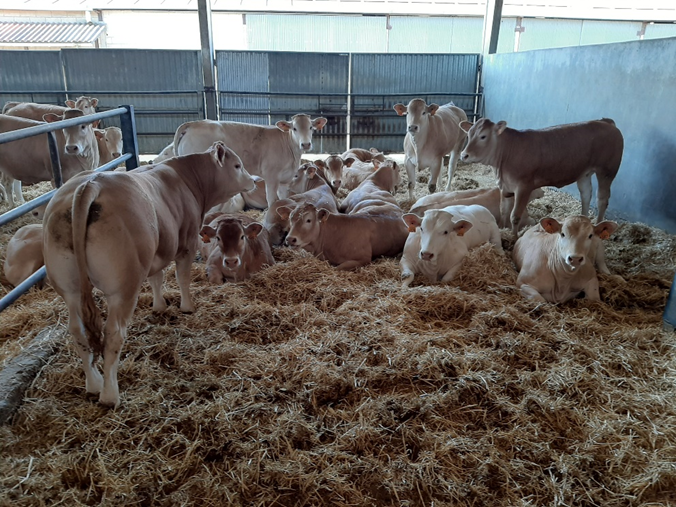This good practice was prepared by Paola Eguinoa Ancho (INTIA).
Introduction to the challenge addressed
Strategies that can minimize the risk of introducing disease on beef farms, such as vaccination status, vaccination programs, or that can reduce the impact on herd health such as feeding practices or group size management.
Good Practice implemented in two Spanish Pyrenees farms. The first described farm is a fattening farm, which purchases its calves in France. The second farm is a sucker beef farm with heifers for sale.
Description of the Good Practice
A health program is a herd-controlled management whose objectives are to reduce potential health risks during calf introduction, reduce disease emergence and spreading, prevent growth rate reduction and lower meat production, reduce mortality and associated economic losses. Two farm cases are described below.
Case 1: Fattening farm
This farm protocol consists in the buying of calves from France, which are free from tuberculosis, brucellosis, and IBR, and which are vaccinated for bluetongue seropositive 8. At arrival, calves must be quarantined and examined regularly against tuberculosis. They are submitted to a deworming and vaccination programme with the following treatments:
- During weaning, it is recommended deworming calves against ecto- and endoparasites with IVOMEC or a similar medicine.
- Vaccination against pneumonia (IBR, BVD, Parainfluenza, Syncytial and Pasteurella) with TRIANGLE4, CATLE MASTER or a similar vaccine
- Vaccination against enterotoxaemia with MILOXAN or a similar vaccine
- Vaccinations against other disease (e.g. PASTEURELA),
To prepare for spring arrivals, this program recommends vaccinating the suckling calves against enterotoxaemia with MILOXAN or a similar vaccine 20 days before outdoor grazing starts. Furthermore, it should be checked if there are any sick animals in the area.
Heifers should be dewormed and receive a booster vaccine against pneumonia (IBR) in autumn, and a vaccine against anthrax (e.g. MILOXAN) during spring.
Adult cows should be vaccinated during spring against enterotoxaemia (e.g. MILOXAN) before going out to pasture; they should be dewormed against ecto- and endoparasites during autumn.
Cows between the 7th and 8th month of gestation should be vaccinated against diarrheal syndrome, rotavirus, coronavirus, Escherichia coli, etc.
Feeding:
Young calves receive hay ad libitum and fibrous feed, low in energy and protein until they are 20 days old. After 20 days calves receive a grower feed (1.01 UFC; 12.5-13.5% PB; 34-37% starch) until 4 months of age. After 4 months calves receive feed for the finishing phase (1.15 UFC; 11.5-12.5% PB; 40% starch) for 2 months, straw is available ad libitum.

Case 2: Sucker beef farm
The good practice implemented in this farm reveals that an important point is to pay attention at the entrance of new animals in the herd and to avoid mixing groups. Calves do not graze in the mountains because it could cause them health problems. An objective is to avoid stress for calves during weaning and their arrival at fattening. The weaning period ends at 4-4.5 months, and then the cows can go to the mountains. The calves start the fattening period from 4-4.5 months up to 11-12 months. Pregnant females graze on mountains pastures and farmers do a pre-partum follow-up (feeding control) at 8 months of pregnancy. The farmer selects animals based on udders, legs and behaviour.
Calves are vaccinated against anthrax 3-4 weeks before they are going to pasture, receive a booster vaccine and are dewormed at weaning. Adult cows are vaccinated twice against IBR. Furthermore, the area where the farm is located is facing besnoita, which is a reproductive disease spread by natural reproduction. That is why the farmer only carry out artificial inseminations.
Usually, 50 to 60 females and 12 to 14 males are for sale. The farmer carries out a routine sanitation program and vaccinates the animals against IBR for some destination areas.
The main challenges found in both farms were that the preventive use of antibiotics is now prohibited, as well as the unrestricted use of antibiotics in drinking water. Using antibiotics now requires a curative purpose and sometimes even an antibiogram. Key success factors for implementation are following a rigorous protocol, a vaccination programme, and the booster vaccines. The main lesson learned for implementation is that there is an important complementarity between quarantine, surveillance of calves, vaccination programmes, feeding practices and especially herd management.

Impacts
Socio-economic resilience: Long-term positive economic effect by using vaccines and thus avoiding economic losses e.g. through lower mortality rates or increased growth rates
Animal health and welfare: Increased animal welfare through healthier animals. Reduction in mortality rate. Preventing antibiotic resistance through the responsible use of antibiotics.
Production efficiency and meat quality: Prevention of growth rate diminution. Reduction in mortality rate.
Environmental sustainability: Lower use of antibiotics due to the abolition of preventive use.
Farmer comment
“You learn from failure” Javier INIGUEZ
Further information
Video: https://www.youtube.com/watch?v=G9UQofXZKpM